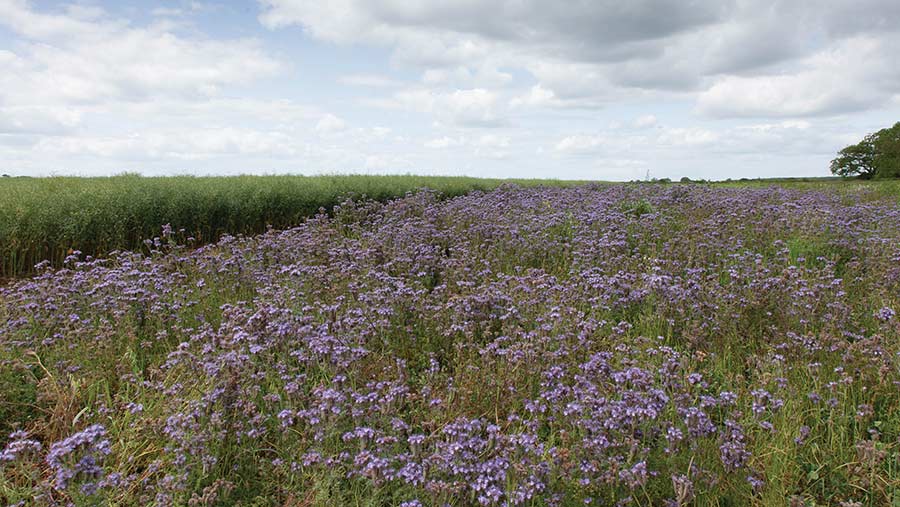Farmers turn to wildflowers and bird cover after costly harvest
 © Tim Scrivener
© Tim Scrivener Farmers are seriously considering sowing more crops for pollinators and wild birds under the Sustainable Farming Incentive, rather than arable crops, as way of reducing their risks and future-proofing their businesses.
This year’s costly and difficult harvest has prompted some farmers to consider different options to growing crops such as wheat and barley after these struggled to reach their potential due to extreme weather events, which affected yields and quality.
But some have raised concerns that a widespread move in this direction could jeopardise UK food production, dragging self-sufficiency below the current 60% mark, with any shortfall needed be made up by imports.
See also: SFI 2023: What’s on offer for arable farmers
Under Defra’s Sustainable Farming Incentive (SFI), farmers and land managers can be paid attractive sums to plant wildflowers and winter bird food, which many believe offer a more stable option than growing more variable break crops such as linseed and spring beans.
A controlled rollout of the 2023 SFI scheme is due to start in England on Monday 18 September.
Removing risks
Berkshire farmer Colin Rayner is eyeing the high-paying SFI actions for farmland wildlife on arable land, including pollen and nectar flower mixes, grassy field corners and winter bird food, which pay £592-£732/ha each year.
“I never thought I’d see myself as a farmer growing flowers rather than food crops,” said Mr Rayner, director of J Rayner & Sons, based in Horton. “The main reason for doing so is removing the risks of growing wheat, barley and oilseed rape.
“Each year, we put all the crops in, they look beautiful and then the weather takes its toll. We’re lucky if we get one in five good harvests these days.”
Mr Rayner is leaning towards the flexibility of the SFI scheme, including its more regular payments and shorter contract terms, than Countryside Stewardship.
De-risking
Essex arable farmer David Lord farms 700ha at Earls Hall Farm, near Clacton on Sea. He believes most progressive farmers will be looking at trying to de-risk their businesses through more stable SFI options.
For his marginal land, Mr Lord is considering wild bird cover and flower-rich margins.
For more productive land, he is exploring a one-in-five-year break crop rotation and choosing an option from the SFI that has more agronomic benefit than growing a traditional break crop, such as oilseed rape.
“The whole thing is a bit of a game-changer when you get your head around it,” he said.
Martin Lines, chief executive of the Nature Friendly Farming Network, knows many farmers who are even planning to put their whole acreage into stewardship agreements this year.
“They feel there is more of a guaranteed income from growing wildflowers for pollinators or being rewarded for having overwinter stubbles than there is from growing a break crop with lower returns and higher risk,” he said.
Food production threat
Steve Cook, an agronomist at Hampshire Arable Systems, said the SFI standards may work for marginal land, but farmers with productive land are likely better off sticking to food crops.
“Margins of fields, wet areas near watercourses – SFI all makes sense. But when people are taking whole farms out, that becomes more of an issue,” he warned.
“There are concerns from us as agronomists because every acre we take out of production, that food still has to be produced somewhere to feed the world.
“What worries me is someone will just chop down a bit more rainforest to do it and it’s counterproductive on a global scale.”
Balance the risk and reward of extensive SFI agreements, says consultant
There is no upper limit on the area of land farmers can enter into the scheme, but care should be taken when selecting significant areas of Sustainable Farming Incentive (SFI) standards, says Ceres Rural partner Charles Garrard.
“Current SFI guidance states that if you were to enter 50ha into the legume fallow under SFI, you would be obliged to grow no less than 50% of that original area in the two subsequent years,” he noted.
Farmers should also balance the wider agronomic risks and rewards of entering into some of the SFI standards, Mr Garrard said.
“Poorly established or thin areas of legume fallows or winter bird mixes – like any poor arable crop – will open the door for troublesome grassweeds,” he added.
“From our experience of whole field options in Countryside Stewardship, those areas given the time, care and attention will deliver the best return, and wider environmental benefits. They need active management to perform like they should.”
Overall, Mr Garrard believes the updates to the SFI are a positive option, and farmers could use them “to help de-risk the more volatile crops within their wider rotations”.

